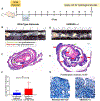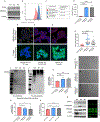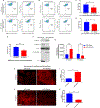UBXN2A suppresses the Rictor-mTORC2 signaling pathway, an established tumorigenic pathway in human colorectal cancer
- PMID: 37037900
- PMCID: PMC10287065
- DOI: 10.1038/s41388-023-02686-7
UBXN2A suppresses the Rictor-mTORC2 signaling pathway, an established tumorigenic pathway in human colorectal cancer
Abstract
The mTORC2 pathway plays a critical role in promoting tumor progression in human colorectal cancer (CRC). The regulatory mechanisms for this signaling pathway are only partially understood. We previously identified UBXN2A as a novel tumor suppressor protein in CRCs and hypothesized that UBXN2A suppresses the mTORC2 pathway, thereby inhibiting CRC growth and metastasis. We first used murine models to show that haploinsufficiency of UBXN2A significantly increases colon tumorigenesis. Induction of UBXN2A reduces AKT phosphorylation downstream of the mTORC2 pathway, which is essential for a plethora of cellular processes, including cell migration. Meanwhile, mTORC1 activities remain unchanged in the presence of UBXN2A. Mechanistic studies revealed that UBXN2A targets Rictor protein, a key component of the mTORC2 complex, for 26S proteasomal degradation. A set of genetic, pharmacological, and rescue experiments showed that UBXN2A regulates cell proliferation, apoptosis, migration, and colon cancer stem cells (CSCs) in CRC. CRC patients with a high level of UBXN2A have significantly better survival, and high-grade CRC tissues exhibit decreased UBXN2A protein expression. A high level of UBXN2A in patient-derived xenografts and tumor organoids decreases Rictor protein and suppresses the mTORC2 pathway. These findings provide new insights into the functions of an ubiquitin-like protein by inhibiting a dominant oncogenic pathway in CRC.
© 2023. The Author(s), under exclusive licence to Springer Nature Limited.
Conflict of interest statement
COMPETING INTRESTS
The authors declare no competing financial interests.
Figures








Similar articles
-
Veratridine, a plant-derived alkaloid, suppresses the hyperactive Rictor-mTORC2 pathway: a new targeted therapy for primary and metastatic colorectal cancer.Res Sq [Preprint]. 2024 Oct 25:rs.3.rs-5199838. doi: 10.21203/rs.3.rs-5199838/v1. Res Sq. 2024. PMID: 39502780 Free PMC article. Preprint.
-
UBXN2A, a Ubiquitin-Like Protein, Alters Proteins in mTORC2 Pathway.S D Med. 2022 Oct;75(10):456-458. S D Med. 2022. PMID: 36889268
-
Two distinct mTORC2-dependent pathways converge on Rac1 to drive breast cancer metastasis.Breast Cancer Res. 2017 Jun 30;19(1):74. doi: 10.1186/s13058-017-0868-8. Breast Cancer Res. 2017. PMID: 28666462 Free PMC article.
-
Unmasking the impact of Rictor in cancer: novel insights of mTORC2 complex.Carcinogenesis. 2018 Jul 30;39(8):971-980. doi: 10.1093/carcin/bgy086. Carcinogenesis. 2018. PMID: 29955840 Review.
-
Discrete signaling mechanisms of mTORC1 and mTORC2: Connected yet apart in cellular and molecular aspects.Adv Biol Regul. 2017 May;64:39-48. doi: 10.1016/j.jbior.2016.12.001. Epub 2017 Jan 4. Adv Biol Regul. 2017. PMID: 28189457 Review.
Cited by
-
RICTOR/mTORC2 downregulation in BRAFV600E melanoma cells promotes resistance to BRAF/MEK inhibition.Mol Cancer. 2024 May 16;23(1):105. doi: 10.1186/s12943-024-02010-1. Mol Cancer. 2024. PMID: 38755661 Free PMC article.
-
Unmasking the tumourigenic role of SIN1/MAPKAP1 in the mTOR complex 2.Clin Transl Med. 2023 Oct;13(10):e1464. doi: 10.1002/ctm2.1464. Clin Transl Med. 2023. PMID: 37877351 Free PMC article. Review.
-
Veratridine, a plant-derived alkaloid, suppresses the hyperactive Rictor-mTORC2 pathway: a new targeted therapy for primary and metastatic colorectal cancer.Res Sq [Preprint]. 2024 Oct 25:rs.3.rs-5199838. doi: 10.21203/rs.3.rs-5199838/v1. Res Sq. 2024. PMID: 39502780 Free PMC article. Preprint.
-
Advances and applications of gut organoids: modeling intestinal diseases and therapeutic development.Life Med. 2025 Mar 7;4(2):lnaf012. doi: 10.1093/lifemedi/lnaf012. eCollection 2025 Apr. Life Med. 2025. PMID: 40276096 Free PMC article. Review.
-
Role of Post-Translational Modifications in Colorectal Cancer Metastasis.Cancers (Basel). 2024 Feb 3;16(3):652. doi: 10.3390/cancers16030652. Cancers (Basel). 2024. PMID: 38339403 Free PMC article. Review.
References
-
- Jhanwar-Uniyal M, Wainwright JV, Mohan AL, Tobias ME, Murali R, Gandhi CD, et al. Diverse signaling mechanisms of mTOR complexes: mTORC1 and mTORC2 in forming a formidable relationship. Advances in Biological Regulation. 2019;72:51–62. - PubMed
Publication types
MeSH terms
Substances
Grants and funding
LinkOut - more resources
Full Text Sources
Molecular Biology Databases
Miscellaneous

